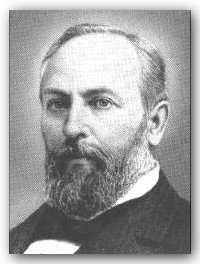 At the election of officials in May, 1880, James W. Paramore became president, succeeding James P. Douglas. Douglas had become interested in another railroad, the Kansas and Gulf Short Line, which proposed to build from Tyler to Lufkin. Although he was the most eminent leader of the Texas and St. Louis Railway Company, this is regarded as the initial step in Paramore's successful control of that organization.
At the election of officials in May, 1880, James W. Paramore became president, succeeding James P. Douglas. Douglas had become interested in another railroad, the Kansas and Gulf Short Line, which proposed to build from Tyler to Lufkin. Although he was the most eminent leader of the Texas and St. Louis Railway Company, this is regarded as the initial step in Paramore's successful control of that organization.
Paramore, who later became known as the "Narrow Gauge King," had a very colorful career before he became connected with the Texas and St. Louis Railway. Born in Mansfield, Ohio, on December 27, 1830, he first gained prominence as a soldier in the Civil War. He was mustered into service as Major of the Third Regiment Ohio Cavalry, with which he served for three years, receiving his honorable discharge in 1863. Called again to the "colors" with the rank of Colonel, he performed gallantly throughout the Tennessee campaigns. By mere coincidence, he was opposed by the artillery command of Major James Douglas at the battle of Murfreesboro.
After the war, Colonel Paramore started his railroad career as the general superintendent of the Tennessee and Pacific Railroad. This company, which is the predecessor to the present Tennessee Central, intended to build from Nashville to Knoxville. In the spring of 1876, he began canvassing the counties of Davidson, Williamson, and Smith for aid to assist in building this road, and was able to secure $500,000 in bonds from each county. The road was built to Lebanon, but could not obtain sufficient capital to complete the line to Knoxville. As nothing could be done for some time, Paramore decided to go into the cotton business in St. Louis, Missouri. With several other men he organized the St. Louis Cotton Compress Company, whose desire was to establish St. Louis as a gateway to the Eastern states for the cotton of the Southwest. The bulk of the Texas cotton was being shipped to Galveston, then to New Orleans, and up the Mississippi and Ohio Rivers to the East. Pnrnmore immediately saw the advantage of a direct rail connection between St. Louis and Texas. He persuaded his associates to purchase the struggling Tyler Tap Railroad, and by joining the Iron Mountain system at Texarkana, they would have their connection into St. Louis. Soon, however, most of his time was taken up with operating this railroad, and he decided to resign from the compress company and devote his entire energy to his rail project.
Return to Presidents of Cotton Belt
Return to History of Cotton Belt
Return to Cotton Belt Railway Web Site